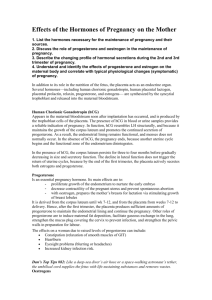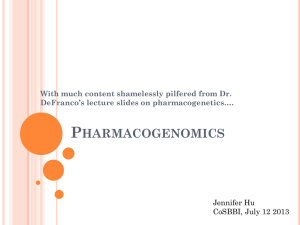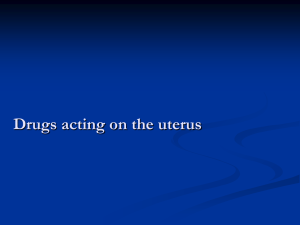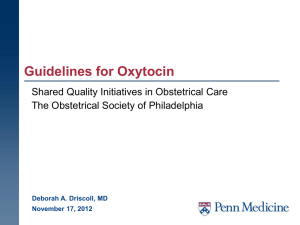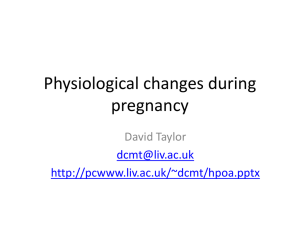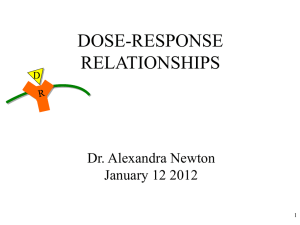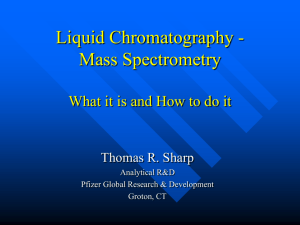Pharmacology of Uterotonics
advertisement
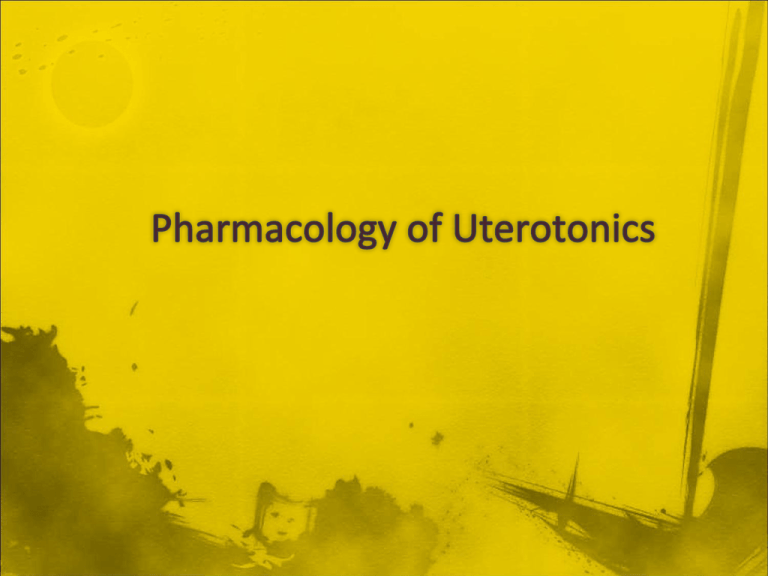
Oxytocin Oxytocin Prostaglandin Ergot alkaloid Progesterone antagonist Tocolytics • • • • • -adrenergist agonist Ca2+-channel blocker PG-synthase inhibitors Magnesium Sulfate Ethanol Biosynthesis • a cyclic non peptic, structurally similar to vasopressin • synthesized as a larger precursor molecul • rapidly broken down to the active hormone • packaged into secretory granules as and oxytocinneurophysin complexs • secreted from nerve ending primarily in the posterior pituitary gland (neurohypophyses) Uterus Stimulates contraction : frequency and force highly dependent on estrogen immature uterus : resistance Responsiveness : paralel to spontaneous activity Exogenous oxytocin : enhance rythmic contraction high dose for early pregnancy Breast milk ejection Oxytocin 1,4,5 triphosphate • mobilization Ca2+ intracellular • activation voltage-sensitive Ca2+ channels Local prostaglandin production • Induction of labor (selected) risk of continued pregnancy isoimmunization intrauterine growth retardation placental insufficiency • Augmentation of labor should not be used : progressing normally hypotonic contraction in disfunctional labor complication : trauma of the mother / fetoes uterine rupture compromized fetal oxygenation very prolong latent phase of cervical dilation arrest / descent of dilation epidural anesthesia • Third stage of labor and puerperium after delivery or following therapeutic abortion • Oxytocin challenge test pregnancy hold increased risk for maternal or fectal complication • Oxytocin receptor antagonists competitively inhibit the interaction of oxytocin with its membran receptor potential use in the treatment of preterm labor HPETEs Inhibitors of Eicosanoid Biosynthesis • Calcium reducer • Glucocorticoids • NSAIDs • Analogs of the natural fatty acid precursores Cardiovascular system prostaglandin tromboxan A2 leukotriens Blood Smooth muscle bronchial and tracheal uterus continued PGFs contracted TXA PGEs : relaxes Non pregnant : contractile > before menstruation relaxation > midcycle Pregnant : PGFs contracted low concentration PGE2 high concentration PGE2 relaxed PGI2 Tone, frequency & intensity of iv PGE2 rhytmic contraction > PGF2 continued Gastric and intestinal secretion Kidney and Urine Formation Central Nervous System Endocrine Metabolic effects Therapeutic abortion abortifacients when given early in pregnancy dinoprostone (PGE2) misoprostol (PGE1) + mifepristone or methotrexate Gastric Cytoprotection Impotence Maintenance of Patent Ductus Arteriosus Pharmacokinetic • Absorption : variably from GI tract Oral dose of ergotamine 10x > im dose speed of absorption and peak blood level can be improved with caffeine Also absorbed from buccal cavity, rectum and after aerosol inhaler • Metabolism : extensive A MOA : agonist at -adrenoceptor & partial agonist serotonin receptor antagonist agonist at dopamine CNS receptor uterus : agonist / partial agonist at 5-HT2R B Organ system effects CNS Vascular smooth muscle Uterine smooth muscle Other smooth muscle Clinical Uses : A. Migraine B. Hyperprolactinemia C. Postpartum hemorrhage D. Diagnosis of Variant Angina E. Senile Cerebral Insufficiency Toxicity : - gastrointestinal - medullary vomiting centre - prolong vasospasm * large doses of nitroprusside - fibroblastic changes * periodic drug holidays (methysergide) Contraindication : - obstructive vascular diseases - collagen disease - (pregnancy) Mifepristone (RU486) derivate of the 19-norprogestin norethindrone competitive antagonist of glucocorticoid and progesterone Pharmacological actions : - antagonist progesterone - mifepristone - antagonist invivo - agonist invitro - onapristone - antagonist invivo & invitro Early stage of pregnancy Decidual breakdown Detachment of the blastocyst h CG < Progesterone < PG > Contraction Pharmacokinetics : - orally active - good bioavailability - peak plasma : several hours - H.L. : 20-40 hours - Binding 1 – acid glycoprotein - Liver metabolism & enterohepatic circulation - Excretion : > faeces Therapeutic Uses : - Mifepristone termination early pregnancy + misoprostol - Mifepristone (48 hours) medical abortion T 1 + prostaglandin - Postcoital contraceptive treatment of Preterm Labor * bedrest * hydration * sedation (+ tocolytics) Ritodrine Terbutaline Tachycardia Hypotension edema Hypo kalemia Hyperglycemia Pulmonary Palpitation, tremor, angina iv. to arrest premature labor can prolong pregnancy Inhibit preterm labor Overt inebriation iv : impaired gag reflex Carbohydrate metabolism more serious in diabetic Crosses placenta Inhibit labor Oral / rectal endomethacin effective in the treatment of preterm labor Serious potential ADR in the fetoes Verapamil and nifedipine Inhibition of premature labor Nifedipine : - decreasing uterine contraction - severe dysmenorrhea - PG – induced abortion Inhibiting premature labor antagonizes Ca 2+ Agent of choice in diabetic patients Crosses placenta // maternal level Respiratory depression in the mother : 10 ml of 10% calcium gluconate Diazoxide Aminophylline Progesterone
